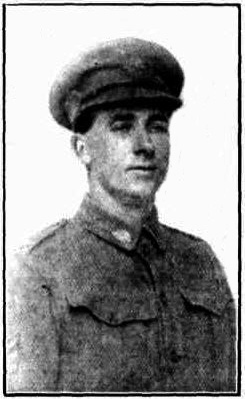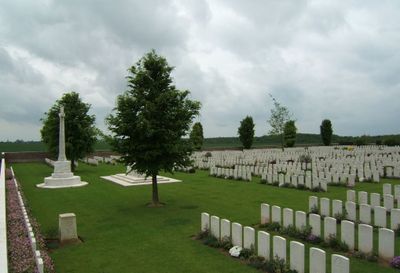Frederick James Bishop
From Our Contribution
 Western Mail 4 Oct 1918 page 21 | |
| Personal Information | |
|---|---|
| Date of Birth | 11 Mar 1894 |
| Place of Birth | Mundijong, Western Australia |
| Death | 23 Jun 1918 |
| Place of Death | Somme Valley, east of Amiens |
| Age at Enlistment | 22 years, 3 months |
| Description |
5' 11½" (1.82m) tall ; 152 lbs 68.946 kg ; medium complexion ; blue eyes ; light hair |
| Occupation | Farrier |
| Religion | Church of England |
| Address | Anstey street, Mundijong, Western Australia |
| Next of Kin | Mother , Mrs. Margaret Bishop |
| Military Information | |
| Reg Number | 1897 |
| Date of Enlistment | 21 Jun 1915 |
| Rank | Sergeant |
| Unit/Formation | 28h Battalion, 3rd Reinforcement, transferred to 32nd Battalion, D Company / 8th Brigade, 5th Division |
| Date of Embarkation | 2 Sep 1915 ‒ ?? Sep 1915 |
| Ship Embarked On | HMAT A68 Anchises Fremantle to Egypt |
| Fate |
Wounded in Action 19 Jul 1916 at Fromelles Killed in Action 23 Jun 1918 in the Somme |
| Monument |
Mundijong School Roll of Honour Mundijong Honour Roll ANZAC Memorial Park (Byford) Canning Honour Roll Australian War Memorial |
| Medals |
1914-15 Star British War Medal Victory Medal |
Contents
[hide]Pre War
War Service
A member of the 3rd reinforcement draft for the 28th Battalion, Fred trained at Blackboy Hill camp before being shipped on HMAT A68 Anchises from Fremantle on 2 Sep 1915 for a training unit in Egypt.
Although he is recorded as having been taken on strength at Gallipoli by the 28th Battalion on 12 Oct 1915, he had in fact joined the 28th Battalion in the field on the evening of the 11th October when they were located on Lower Cheshire Ridge. Fred was admitted to 7th Field Ambulance ill on 31 Oct 1915, and released to duty on 3 Nov 1915. He remained with the 28th Battalion until their return to Egypt. During November they had been engaged primarily on working parties and on beach fatigues. Early December was spent at Russell's Top, and on 12 Dec 1915 they were relieved by the 20th Battalion and were evacuated to Lemnos Island aboard HMT Osmanieh. On 6 Jan 1916 the battalion embarked on HMT Ausonia for Alexandria, disembarking there on 10 Jan 1016.
Fred was transferred to the 32nd Battalion in Egypt on 10 Mar 1916 as part of the doubling of the size of the AIF. He was appointed a Lance Corporal on 26 May 1916, and along with the rest of his unit, he left Alexandria on 18 Jun 1916 aboard HMT Transylvania for Marseilles in France, arriving there on the 23 Jun 1916. The battalion then travelled by train to Steenbecque, where they disembarked before marching to Morbecque where they went into camp on 26 Jun 1916.
Within a short time of their being introduced to the front line trenches they were engaged in what became the Battle of Fromelles. While the unit's War Diary doesn't speak of enemy shellfire on 19 Jul 1916, it would have occurred during both the attack, and afterwards as they sought to hold the ground that they had won. Fred's injury was caused by a shell - a wound to his arm during an attack near Fleurbaix in the northern sector of the battle for Fromelles. Treated by the 15th Field Ambulance, followed by the 2nd Australian Casualty Clearing Station , he was placed on an Ambulance Train on the 20th for the 3rd Canadian Hospital in Boulogne. Fred was back with his unit on 15 Aug 1916.
However, on 8 Sep 1916 he was ill (Shell shock) and he re-entered hospital until 15 Sep 1916 when he rejoined the battalion. On 16 Oct 1916 he was detached to the 4th Army School and promoted to Sergeant on 20 Oct 1916, but soon after on 30 Nov 1916 he was again ill and entered hospital to receive treatment for Trench Feet. This time having passed through the hands of the 1st Anzac Main Dressing Station, the 36th Casualty Clearinf Station, and the 3rd Stationary Hospital in Rouen he was evacuated to England onboard HMHS St Andrew on 19 Dec 1916, and entered the Reading War Hospital. Following treatment he was granted furlough from 21 Feb until 8 Mar 1917 after which he was to report to Perham Downs where he was medically reclassified as 'Bla'.
In March 1917 he was fit to begin the journey back to his unit via a training course for Sergeants, some leave, and the inevitable depot units, reaching the 32nd Battalion again on 23 Feb 1918. Fred was engaged with his unit and all the Australian units in stopping the German advance on Amiens, before participating in concerted attacks on the German positions in the Somme region during the remainder of 1918. 'D' Company of the 32nd Battalion entered front line trenches on 21 Jun 1918 near the Somme River.
Fred's Red Cross file [1] entry quotes Pte W. Anderson who on 6 Aug 1918 described Fred's death .....
"We were in supports between Sailly-Laurette and Morlancourt when a shell landed on a dug out where Sgt Bishop was resting, he was buried by the fall of earth and died instantaneously. When we pulled him out he was practically in pieces. I don't know where he was buried."
Capt Crinks and Cpl Shilcock were also buried with him by the shell burst. Apparently they had just returned from a raid at about 10:00am and were being relieved when the shell landed. Capt Crinks who had led the raid was wounded and taken to the Casualty Clearing Station. Another member of his unit 6240 Private A.J. Grimwade said
"Near Dernancourt in June, when we had just got back from a raid about 10:00 in the morning, and were being relieved, a shell landed and buried up 3 men, Bishop, Capitan Drinks and Corporal Shilcock. I went up to help dig them out. We found Bishop's body and he was taken for burial to the R.A.P. where there were others buried."
Fred is also listed on the Canning War Memorial as his parents moved there prior to the end of the war.
Notes
Buried Heath Cemetery (Plot VII, Row G, Grave 6)
- Jump up ↑ "Australian Red Cross Wounded and Missing Files - Frederick James Bishop". Australian War Memorial. 2018. Retrieved 2 May 2018.

